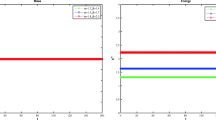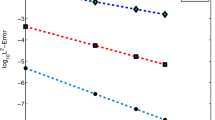Abstract
In this work, two novel classes of structure-preserving spectral Galerkin methods are proposed which based on the Crank–Nicolson scheme and the exponential scalar auxiliary variable method respectively, for solving the coupled fractional nonlinear Klein–Gordon–Schrödinger equation. The paper focuses on the theoretical analyses and computational efficiency of the proposed schemes, the Crank–Nicoloson scheme is proved to be unconditionally convergent and has maximum-norm boundness of numerical solutions. The exponential scalar auxiliary variable scheme is linearly implicit and decoupled, but lack of the maximum-norm boundness, also, the energy structure is modified. Subsequently, the efficient implementations of the proposed schemes are introduced in detail. Both the theoretical analyses and the numerical comparisons show that the proposed spectral Galerkin methods have high efficiency in long-time computations.








Similar content being viewed by others
Data Availability
Enquiries about data availability should be directed to the authors.
References
Alfimov, G., Pierantozzi, T., Vázquez, L.: Numerical study of a fractional sine-Gordon equation. Fract. Differ. Appl. 4, 153–162 (2004)
Ainsworth, M., Mao, Z.: Analysis and approximation of a fractional Cahn–Hilliard equation. SIAM J. Numer. Anal. 55, 1689–1718 (2017)
An, J., Cao, W., Zhang, Z.: An efficient spectral Petrov–Galerkin method for nonlinear Hamiltonian systems. Commun. Comput. Phys. 26, 1249–1273 (2019)
Browder, F.: Existence and uniqueness theorems for solutions of nonlinear boundary value problems. In: Application of Nonlinear Partial Differential Equations. Proceedings of Symposia in Applied Mathematics, vol. 17, pp. 24-49 (1965)
Boulenger, T., Himmelsbach, D., Lenzmann, E.: Blowup for fractional NLS. J. Funct. Anal. 271, 2569–2603 (2016)
Brugnano, L., Iavernaro, F.: Line Integral Methods for Conservative Problems. Chapman Hall/CRC, Boca Raton (2016)
Bao, W., Zhao, X.: A uniformly accurate (UA) multiscale time integrator Fourier pseudospectral method for the Klein–Gordon–Schrödinger equations in the nonrelativistic limit regime. Numer. Math. 135, 833–873 (2017)
Feng, K., Qin, M.: Symplectic Geometric Algorithms for Hamiltonian Systems. Springer, Berlin (2010)
Felmer, P., Quaas, A., Tan, J.: Positive solutions of the nonlinear Schrödinger equation with the fractional Laplacian. Proc. R. Soc. Edinb. Sect. A 142, 1237–1262 (2012)
Fu, H., Liu, H., Wang, H.: A finite volume method for two-dimensional Riemann–Liouville space-fractional diffusion equation and its efficient implementation. J. Comput. Phys. 388, 316–334 (2019)
Feng, X., Liu, H., Ma, S.: Mass- and energy-conserved numerical schemes for nonlinear Schrödinger equations. Commun. Comput. Phys. 26, 1365–1396 (2019)
Fu, Y., Cai, W., Wang, Y.: Structure-preserving algorithms for the two-dimensional fractional Klein–Gordon–Schrödinger equation. Appl. Numer. Math. 156, 77–93 (2020)
Hairer, E., Lubich, C., Wanner, G.: Geometric Numerical Integration: Structure-Preserving Algorithms for Ordinary Differential Equations, 2nd edn. Springer, Berlin (2006)
Hajaiej, H., Yu, X., Zhai, Z.: Fractional Gagliardo–Nirenberg and hardy inequalities under Lorentz norms. J. Math. Anal. Appl. 396, 569–577 (2012)
Huang, J., Nie, N., Tang, Y.: A second order finite difference-spectral method for space fractional diffusion equations. Sci. China Math. 57, 1303–1317 (2014)
Hu, D., Cai, W., Song, Y., Wang, Y.: A fourth-order dissipation-preserving algorithm with fast implementation for space fractional nonlinear damped wave equations. Commun. Nonlinear Sci. Numer. Simul. 91, 105432 (2020)
Hu, D., Cai, W., Gu, X., Wang, Y.: Efficient energy preserving Galerkin–Legendre spectral methods for fractional nonlinear Schrödinger equation with wave operator. Appl. Numer. Math. 172, 608–628 (2022)
Ionescu, A., Pusateri, F.: Nonlinear fractional Schrödinger equations in one dimension. J. Funct. Anal. 266, 139–176 (2014)
Kirkpatrick, K., Lenzmann, E., Staffilani, G.: On the continuum limit for discrete NLS with long-range lattice interactions. Commun. Math. Phys. 317, 563–591 (2013)
Laskin, N.: Fractional quantum mechanics and Lévy path integrals. Phys. Lett. 268, 298–305 (2000)
Longhi, S.: Fractional Schrödinger equation in optics. Opt. Lett. 40, 1117–1120 (2015)
Lu, K., Wang, B.: Global attractors for the Klein–Gordon–Schrödinger equation in unbounded domains. J. Differ. Equ. 170, 281–316 (2001)
Li, M., Huang, C., Zhao, Y.: Fast conservative numerical algorithm for the coupled fractional Klein–Gordon–Schrödinger equation. Numer. Algorithm 84, 1081–1119 (2020)
Liu, Z., Li, X.: The exponential scalar auxiliary variable (E-SAV) approach for phase field models and its explicit computing. SIAM J. Sci. Comput. 42, B630–B655 (2020)
Mendez, A.: On the propagation of regularity for solutions of the fractional Korteweg-de Vries equation. J. Differ. Equ. 269, 9051–9089 (2020)
Macías-Díaz, J.: Existence of solutions of an explicit energy-conserving scheme for a fractional Klein–Gordon–Zakharov system. Appl. Numer. Math. 151, 40–43 (2020)
Nezza, E., Palatucci, G., Valdinoci, E.: Hitchhiker’s guide to the fractional Sobolev spaces. Bull. Sci. Math. 136, 521–573 (2012)
Quispel, G., McLaren, D.: A new class of energy-preserving numerical integration methods. J. Phys. A Math. Theor. 41, 045206 (2008)
Roop, J.: Variational Solution of the fractional advection dispersion equation. Ph.D. thesis, Clemson University, Clemson, SC (2004)
Shen, J., Tang, T., Wang, L.: Spectral Methods: Algorithms, Analysis and Applications. Springer Series in Computational Mathematics, Springer, Springer, Heidelberg (2011)
Shen, J., Xu, J., Yang, J.: The scalar auxiliary variable (SAV) approach for gradient flows. J. Comput. Phys. 353, 407–416 (2018)
Shi, Y., Ma, Q., Ding, X.: A new energy-preserving scheme for the fractional Klein–Gordon–Schrödinger equations. Adv. Appl. Math. Mech. 11, 1219–1247 (2019)
Shi, Q., Zhang, X., Wang, C., Wang, S.: Finite time blowup for Klein–Gordon–Schrödinger system. Math. Methods Appl. Sci. 42, 3929–3941 (2019)
Wang, B., Lange, H.: Attractors for the Klein–Gordon–Schrödinger equation. J. Math. Phys. 40, 2445–2457 (1999)
Wang, Y., Wang, B., Qin, M.: Local structure-preserving algorithms for partial differential equations. Sci. China Ser. A Math. 51, 2115–2136 (2008)
Wang, P., Huang, C.: An energy conservative difference scheme for the nonlinear fractional Schrödinger equations. J. Comput. Phys. 293, 238–251 (2015)
Wang, Y., Mei, L.: A conservative spectral Galerkin method for the coupled nonlinear space-fractional Schrödinger equations. Int. J. Comput. Math. 96, 2387–2410 (2019)
Yang, X., Ju, L.: Efficient linear schemes with unconditional energy stability for the phase field elastic bending energy model. Comput. Methods Appl. Mech. Eng. 315, 691–712 (2017)
Zhou, Y.: Application of Discrete Functional Analysis to the Finite Difierence Methods. International Academic Publishers, Beijing (1990)
Zhao, X., Sun, Z., Hao, Z.: A fourth-order compact ADI scheme for two-dimensional nonlinear space fractional Schrödinger equation. SIAM J. Sci. Comput. 36, A2865–A2886 (2014)
Zeng, F., Liu, F., Li, C., Burrage, K., Turner, I., Anh, V.: A Crank–Nicolson ADI spectral method for a two-dimensional Riesz space fractional nonlinear reaction–diffusion equation. SIAM J. Numer. Anal. 52, 2599–2622 (2014)
Zhang, Y., Shen, J.: Efficient structure preserving schemes for the Klein–Gordon–Schrödinger equations. J. Sci. Comput. 89, 47 (2021)
Acknowledgements
This work is partially supported by the National Natural Science Foundation of China (Grant Nos. 12171245, 11971242) and the Research Start-up Foundation of Jiangxi Normal University (Grant No. 12021997).
Author information
Authors and Affiliations
Corresponding author
Ethics declarations
Conflict of interest
The authors declare that they have no conflict of interest.
Additional information
Publisher's Note
Springer Nature remains neutral with regard to jurisdictional claims in published maps and institutional affiliations.
Appendices
A Appendix: Proof of (3.11)
Proof
Utilizing the Taylor’s expansion for \(\phi \) and \(\psi \) of (3.5) at \(t=t_{n+1/2}\), we have
in which
and
Assume that \(\phi (\cdot ,t)\in C^3([0,T])\). We deduce
Simultaneously,
Employing the Lagrange’s mean value theorem, we obtain
and
Suppose that \(\phi (\cdot ,t)\in C^4([0,T])\). We get
This completes the proof of (3.11). \(\square \)
B Appendix: Proof of Theorem 3.3
The proof of Theorem 3.3 is divided into two parts, including the existence and uniqueness.
(I) Existence:
Proof
It is worth noting that \(U_N^{n+1}=2U_N^{n+1/2}-U_N^{n}\) and \(\delta _t\Phi _N^{n+1/2}=\Psi _N^{n+1/2}\). We reformulate the spectral Galerkin scheme (3.12)–(3.14) into the following form
Now, we carry out proving the existence of \(U_N^{n+1/2}\) and \(\Phi _N^{n+1/2}\). For convenience, we define the map \({\textbf {s}}=(s_1,s_2)\), \(\mathscr {F}=(\mathscr {F}_1,\mathscr {F}_2):\) \((X_N^0(\Omega ),X_N^0(\Omega ))\rightarrow (X_N^0(\Omega ),X_N^0(\Omega ))\), such that
and
Choosing \(w_N=s_1\) in (B.3) and taking the real part, from the Young’s inequality, we derive
Setting \(w_N=s_2\) in (B.4), by utilizing the Cauchy–Schwarz inequality, we obtain
By employing the boundness of the numerical solutions (see Theorem 3.2) and the Young’s inequality, for sufficient small \(\tau \), we conclude
and
Substituting (B.6)–(B.8) into (B.5), we arrive at
Therefore, we have
Taking \(\delta =\Big \Vert \Big ( 2\Phi _N^{n}+\tau \Psi _N^{n}, \sqrt{2\mathcal {C}}\Big ) \Big \Vert \), which satisfies the condition of Lemma 3.5, we derive
This proves the existence of the numerical solution of (3.12)–(3.14). \(\square \)
Next, we prove the uniqueness of the numerical solution.
(II) Uniqueness:
Proof
We prove the theorem by introduction. It is obvious to find from (3.15) that the numerical solution \((U_N^0,\Phi ^0_N,\Psi _N^0)\in (X_N^0(\Omega ),X_N^0(\Omega ),X_N^0(\Omega ))\) exists and is unique. Assume that \((U_N^n,\Phi ^n_N,\Psi _N^n)\) is the unique solution of (3.12)–(3.14) for \(n=0,1,\ldots ,N_t-1\). Next, we prove the uniqueness of the solution \((U_N^{n+1/2},\Phi ^{n+1/2}_N)\). Assume there are two solutions \(X^{n+1/2}=(X_1^{n+1/2},X_2^{n+1/2})\) and \(Y^{n+1/2}=(Y_1^{n+1/2},Y_2^{n+1/2})\) for scheme (3.12)–(3.14). Then \(X_1^{n+1/2}-Y_1^{n+1/2}\) and \(X_2^{n+1/2}-Y_2^{n+1/2}\) satisfy (B.3) and (B.4) as follows
By the definition of \(\mathscr {F}_1\), we have
Taking the real part of (B.9), by admitting the boundness of the numerical solutions (see Theorem 3.2), Lemma 3.4 and the Cauchy–Schwarz inequality, we obtain
Taking into account of the definition of \(\mathscr {F}_2\), we get
By employing Theorem 3.2, Lemma 3.4 and the Cauchy–Schwarz inequality, we deduce
Summing up (B.10) and (B.11), for a sufficient small \(\tau \), we arrive at
By assuming \(\mathcal {C}\tau <1\), it leads to \(\Big \Vert X^{n+1/2}-Y^{n+1/2} \Big \Vert =0\), which implies \(X_1^{n+1/2}=Y_1^{n+1/2}\) and \(X_2^{n+1/2}=Y_2^{n+1/2}\). This ends the proof of the uniqueness. \(\square \)
Rights and permissions
Springer Nature or its licensor (e.g. a society or other partner) holds exclusive rights to this article under a publishing agreement with the author(s) or other rightsholder(s); author self-archiving of the accepted manuscript version of this article is solely governed by the terms of such publishing agreement and applicable law.
About this article
Cite this article
Hu, D., Fu, Y., Cai, W. et al. Unconditional Convergence of Conservative Spectral Galerkin Methods for the Coupled Fractional Nonlinear Klein–Gordon–Schrödinger Equations. J Sci Comput 94, 70 (2023). https://doi.org/10.1007/s10915-023-02108-6
Received:
Revised:
Accepted:
Published:
DOI: https://doi.org/10.1007/s10915-023-02108-6
Keywords
- Riesz fractional derivative
- Spectral Galerkin method
- Structure-preserving algorithm
- Unique solvability
- Convergence




